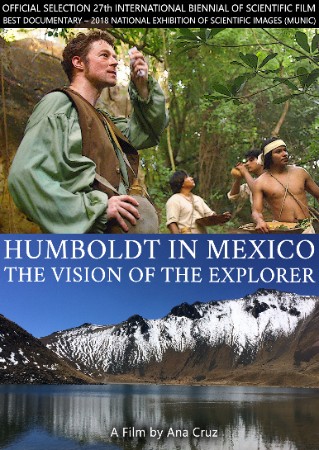
Humboldt in Mexico: The Vision of the Explorer 2017
Distributed by epf media, 324 S. Beverly Drive, PMB 437, Beverly Hills, CA 90212; 310-839-1500
Produced by Ana Cruz Navarro
Directed by Ana Cruz Navarro
Streaming, 83 mins
College
Documentary; Earth Sciences; Human Rights; Natural History
Date Entered: 08/18/2020
Reviewed by Bryan J. Sajecki, University at BuffaloWhen it comes to world exploration, Magellan, Columbus, Cabral, and da Gama are only a handful of names that seem to get all of the attention. Along with many stories of successful exploration often come tales of natives being exploited, disease being spread, and lives being lost. To find a story that is a break from this “norm” is refreshing and uplifting. Enter, Humboldt in Mexico: The Vision of the Explorer; the chronicle of an affable Prussian scientist who wore many hats and singlehandedly changed the scope of natural science.
Born into an aristocratic family in 1769, Humboldt quickly became known as a curious child and desired to expand beyond his own backyard. Over time, he came into extreme wealth through an inheritance, most of which he spent on funding his explorations and literary works. This documentary takes the viewer on an intriguing trip to the New Americas, landing in Acapulco and spending a year traveling through Mexico. Humboldt’s trek was much different than those before him. He traveled with only one other person, French botanist and physicist Aimé Bondpland. Throughout the trip, Bonpland suffered fevers and delirium from malaria, nevertheless managing to assist Humboldt in cataloging hundreds of plant species so meticulously that records of these specimens still exist today. One can locate pages with the initials “HBK” in museums and herbariums around the world.
The film’s director, Ana Cruz, manages to shape the character of the passionate explorer through narrative interviews from experts as well as recitations of his copious journal writings. There are also live action frames interspersed with actors playing the roles of the Humboldt and Bonpland. The viewer gets to hear and see how he helped to initiate integrative botany, sketch the topography of Mexico’s largest mountains, and help improve safety measures for the natives working in New Spain’s silver mines. His great sensitivity and curiosity had no bounds, as one interviewee claimed, “Humboldt was the most important scientist of his time.”
The story of Alexander von Humboldt’s journey through Mexico shows a man who was a humanitarian and respectful individual, constantly remarking on the social injustices of poverty. He even accurately predicted insurrections of colonists if every day living conditions were not improved. His work and ingenuity became a great influence to Charles Darwin, among many other natural scientists.
This documentary will be a great for any academic library, especially one with a focus on natural sciences and history, New American exploration, and human rights. In addition, the film would benefit a younger audience in high schools alongside the general population who may be history buffs. Viewers should take note that Humboldt is filmed in Spanish and contains English subtitles.
Awards:
2018 Winner Best Documentary – National Festival of Scientific Images MUIC; 2018 Winner Humboldt Pride Medal – Alexander von Humboldt German School Students Association